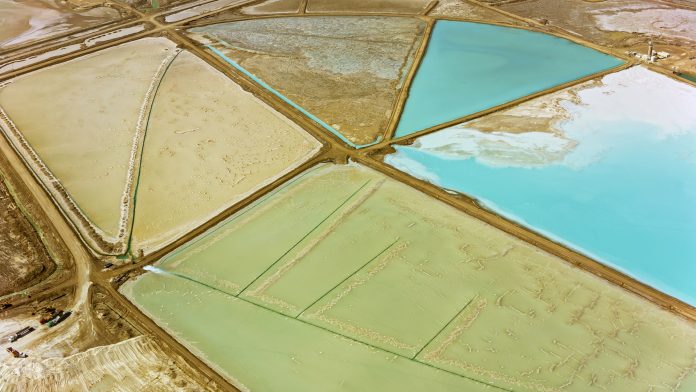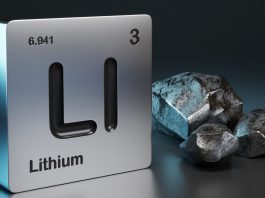Tyre Gray, President of the Nevada Mining Association, discusses Nevada’s role as a domestic lithium source for the US.
Green energy has been a crucial topic and whenever it is discussed, conversations often turn towards the capabilities of lithium. This mineral – which powers smartphones, laptops, and tablets – is also instrumental in the production of electric vehicle (EV) batteries. The amount of lithium required varies by vehicle, but ranges from 17 to 22 pounds.
Demand for lithium has soared, mostly driven by the commitment to switch from combustion engines to EVs. By 2040, demand will increase by 14 times the current levels.
In August 2021, President Biden signed an Executive Order that sets an ambitious goal for 50% of all US auto sales to be zero emissions EVs, including battery electric, plug-in hybrid electric, or fuel cell EVs by 2030.
To put that in perspective, in 2020, 2% of all vehicles sold in the US were electric (231,000 total) and in 2019 the number was 2.6% (245,000 total). To reach President Biden’s 2030 goal, a drastic increase in lithium production is needed.
Current levels of lithium production
Australia was the world leader in terms of lithium mine production in 2021 with Chile and China ranked second and third, followed by Argentina and Brazil. The top three countries had a combined estimated output of 95,000 MT of lithium.
The US currently only has one operating lithium mine, Albemarle’s Silver Peak Operation in Nevada. This requires the US to import lithium in from overseas, leaving the nation reliant on others to fulfil its increased demand.
With rising costs, the US has been forced to re-evaluate its current energy dependence on adversarial nations, creating a renewed emphasis on a domestic transition towards renewable sources. If the US is serious about energy independence, it must commit to the development of a national supply chain that can supply a variety of much-needed minerals. This goal can be achieved by further turning to Nevada and its modern mining industry.
According to S&P Global Market Intelligence, Silver Peak produces lithium from brine extracted from the Clayton Valley basin and has an output capacity of 6,000 tonnes of lithium per year, which represents around 1% of global production. Amid the rising demand, Albemarle also announced plans in 2021 to invest further, with the goal of doubling the capacity of the plant by 2025.
Nevada’s potential as a domestic lithium source Answers to the US’ lithium gap can be found in Nevada. There are currently 15,500 active lithium claims in the state and experts believe that as projects come online, it can put Nevada on the map as a leading global producer.
Projects like Lithium Nevada’s Thacker Pass Mine and Ioneer’s Rhyolite Ridge, that are nearing shovel readiness, can help Nevada lead the way in creating a domestic supply chain. This will be needed to catch up to global competitors overseas, who are drastically outproducing the US in EV development. With these two projects alone, Nevada is capable of producing upwards of 25% of all global production of lithium.
Nevada mining is at the forefront of a renewable future, supporting the continued emergence of the Silver State as the US’ green energy hub.
The Thacker Pass lithium mine
The Thacker Pass mine project (Thacker Pass) is a sedimentary lithium project located in Humboldt County, Nevada. In 2018, Lithium Americas completed a pre-feasibility study (PFS) on a two-phase project with a production capacity designed to reach 60,000 tpa of battery-grade lithium carbonate (Li2CO3) and a 41-year mine life. The projected output has even increased to 80,000 tpa because of efficiencies gained through hundreds of small-scale ore processing tests in a lab in Reno, Nevada.
Lithium Nevada has received all major state permits as well as a Record of Decision from the U.S. Department of Interior. Pre-construction for Thacker Pass is scheduled to begin later this year with the project being developed as a shallow open-pit mining operation using truck and shovel methods. Due to the near-surface and soft nature of the deposit, minimal blasting and crushing is anticipated and the pit will be progressively backfilled throughout the mine-life.
Beyond the mineral capabilities the mine will provide, Thacker Pass is founded on a decade of feedback through community engagement. The project was designed reflecting information collected during numerous stakeholder meetings, open houses, and engagement with the Fort McDermitt Paiute and Shoshone Tribe. Lithium Nevada also meets regularly with the Orovada community and is part of a working group to address community questions about the project.
Economically speaking, the project will have a significant impact on the community. It will create 300 family-supporting jobs once fully up and running and generate $265m in economic activity in Humboldt County during the construction of Thacker Pass facilities.
Throughout the construction period, Lithium Nevada will pay more than $20m in taxes and generate more than $18m in local state and federal taxes from the Humboldt County employment and business activity. Once complete, it will spend, on average, $276m per year in Humboldt County to operate the mine.
Mining must be part of the clean energy transition
Anti-mining advocates will argue three things: that mining cannot be done in an environmentally sustainable way, that we need to focus more on mineral recovery than new mines, and that expediting projects will not allow time for proper review.
One of the reasons Nevada is consistently regarded as one of the world’s best mining jurisdictions is because it is a highly regulated industry, both at the state and federal level. Before a shovel breaks ground, operations are required to submit post-closure reclamation plans and payment to the state of Nevada.
Currently, the state possesses over $3.3bn in reclamation bonds. During operation, mines monitor air, water, and soil over 100 times per day, with measurements required to meet government-set standards. Steps are also taken to protect local ecosystems, vegetation, water, and wildlife. In short, if a Nevada operation cannot mine the right way, they will not be able to remain open, nor should they. The reality is that no one mines better than Nevada.
While mineral recycling will, and should be, an important part of the US’ green energy supply chain, even the most optimistic numbers suggest that recycling will only provide 30-40% of future demand. That additional 70% will have to come from somewhere. If the country ignores that predicament, it will continue to rely on others to provide those materials, placing national security and energy prices at risk.
Finally, expediting projects will still allow ample time for proper review and community input. On average, it takes ten years for a mine to go through the permitting process and begin operations. Those ten years can include periods of deadtime, with operators waiting on permission to move onto the next stage. It is not the fault of any one person or agency, but the result of a complicated process that can be delayed by something as simple as a job vacancy going unfilled.
If the goal is to transition to domestic, renewable energy, Nevada and its modern mining industry must be a part of the solution. The longer the country waits, the more it will be forced to rely on others to provide the minerals needed, creating an uncertain future. Nevada is the key to make the US competitive in the lithium-ion battery markets and it will provide essential materials to combat the climate crisis.
Tyre Gray
President
Nevada Mining Association
www.nevadamining.org
https://www.linkedin.com/company/nevada-mining-association/
https://www.facebook.com/NVMining/
https://twitter.com/
Please note, this article will also appear in the eleventh edition of our quarterly publication.









